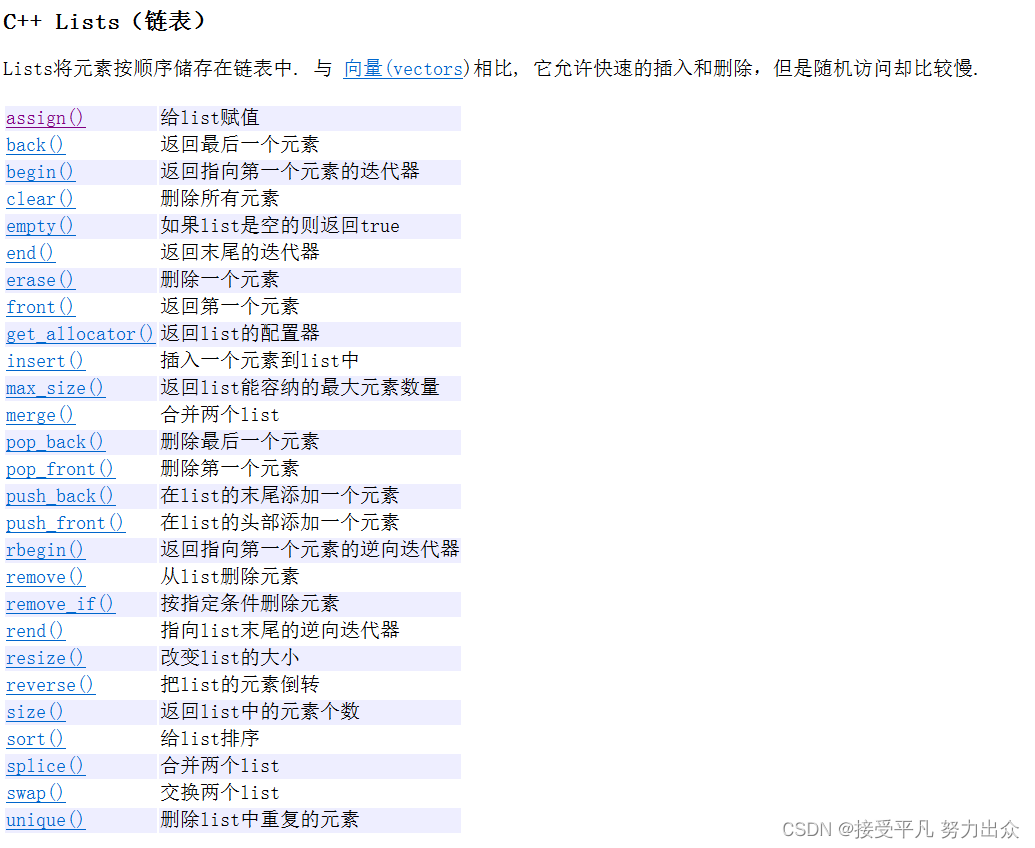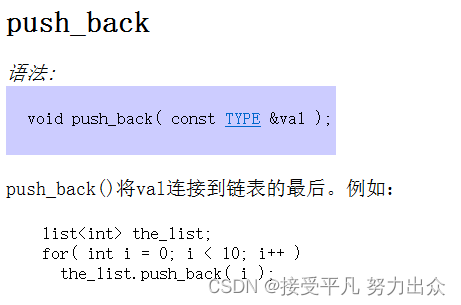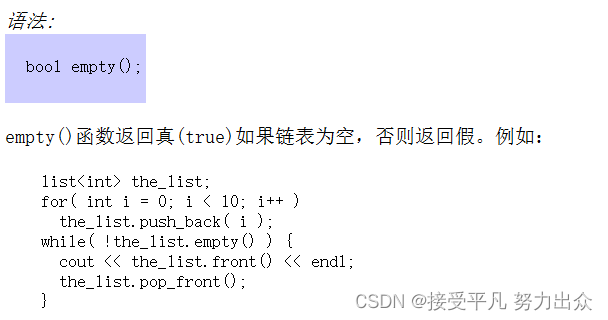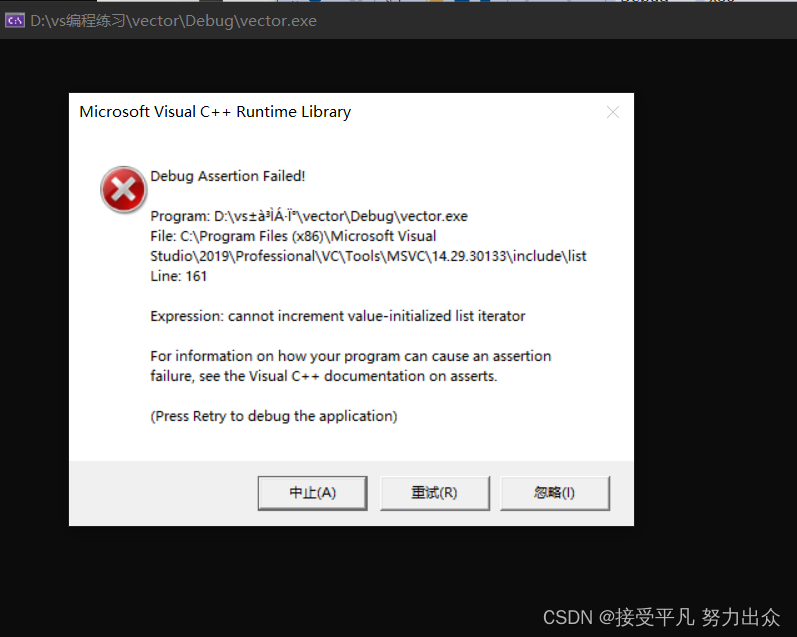list的介绍
list本质是一个带头的双向循环链表
- list是一种可以在常数范围内在任意位置进行插入和删除的序列式容器,并且该容器可以前后双向迭代。
- list的底层是双向链表结构,双向链表中每个元素存储在互不相关的独立结点当中,在结点中通过指针指向其前一个元素和后一个元素。
- list与forward_list非常相似,最主要的不同在于forward_list是单链表,只能进行单方向迭代。
- 与其他容器相比,list通常在任意位置进行插入、删除元素的执行效率更高。
- list和forward_list最大的缺陷是不支持在任意位置的随机访问,其次,list还需要一些额外的空间,以保存每个结点之间的关联信息(对于存储的类型较小元素来说这可能是一个重要的因素)。
list常见接口的介绍

list的构造函数
1.无参构造:list()
list<int> lt1;2.用n个值为val的元素构造:list(size_type n,const value_type& val=value_type())
list<int> lt2(10,2);3.拷贝构造:list(const list& lt)
list<int> lt3(lt2);4. 用一段区间的元素构造list:list(Inputlterator first,Inputlterator last)
string s("hello world");
list<char> lt4(s.begin(),s.end());实例演示
void PrintList(const list<int>& lt)
{
list<int>::const_iterator it = lt.begin();
while (it != lt.end())
{
cout << *it << " ";
++it;
}
cout << endl;
}
void test4()
{
list<int> lt1;
list<int> lt2(5, 2);
list<int> lt3(lt2);
list<int> lt4(lt2.begin(), lt2.end());
cout << "lt1:";
PrintList(lt1);
cout << "It2:";
PrintList(lt2);
cout << "It3:";
PrintList(lt3);
cout << "It4:";
PrintList(lt4);
}代码运行结果如下:

list中迭代器
1.begin和end

通过begin函数可以得到容器中第一个元素的正向迭代器,通过end函数可以得到容器中最后一个元素的后一个位置的正向迭代器。
void test12()
{
list<int> lt(10, 2);
list<int>::iterator it = lt.begin();
while (it != lt.end())
{
cout << *it << " ";
it++;
}
cout << endl;
}运行结果:

2.rbegin和rend

通过rbegin函数可以得到容器中最后一个元素的反向迭代器,通过rend函数可以得到容器中第一个元素的前一个位置的反向迭代器。
void test13()
{
list<int> lt;
lt.push_back(1);
lt.push_back(2);
lt.push_back(3);
lt.push_back(4);
list<int>::reverse_iterator it = lt.rbegin();
while (it != lt.rend())
{
cout << *it << " ";
it++;
}
cout << endl;
}运行结果

list的迭代器遍历
void TestList2()
{
list<int>lt;
lt.push_back(1);
lt.push_back(2);
lt.push_back(3);
lt.push_front(0);
lt.push_front(-1);
lt.push_front(-2);
list<int>::iterator it = lt.begin();
while (it != lt.end())
{
cout << *it << " ";
++it;
}
cout << endl;
for (auto e : lt)
{
cout << e << " ";
}
cout << endl;
list<int>::reverse_iterator rit = lt.rbegin();
while (rit != lt.rend())
{
cout << *rit << " ";
++rit;
}
cout << endl;
}
运行结果:

list的增删查改
1.push_front和pop_front

push_front函数用于头插一个数据,pop_front函数用于头删一个数据。
void test5()
{
list<int> lt;
lt.push_front(1);
lt.push_front(2);
lt.push_front(3);
lt.push_front(4);
for (auto e : lt)
{
cout << e << " ";
}
cout << endl;
lt.pop_front();
for (auto e : lt)
{
cout << e << " ";
}
cout << endl;
}演示:

2.push_back和pop_back

push_back函数用于尾插一个数据,pop_back函数用于尾删一个数据。
void test6()
{
list<int> lt;
lt.push_back(1);
lt.push_back(2);
lt.push_back(3);
for (auto e : lt)
{
cout << e << " ";
}
cout << endl;
lt.pop_back();
for (auto e : lt)
{
cout << e << " ";
}
cout << endl;
}演示:

3.insert

list当中的insert函数支持三种插入方式:
- 在指定迭代器位置插入一个数。
- 在指定迭代器位置插入n个值为val的数。
- 在指定迭代器位置插入一段迭代器区间(左闭右开)。
void test7()
{
list<int> lt;
lt.push_back(1);
lt.push_back(2);
lt.push_back(3);
//1.在指定迭代器位置插入一个数
list<int>::iterator pos = find(lt.begin(), lt.end(), 2);
lt.insert(pos, 9);
for (auto e : lt)
{
cout << e << " ";
}
cout << endl;
//2.在指定迭代器位置插入n个值为val的数
pos = find(lt.begin(), lt.end(), 3);
lt.insert(pos, 2, 8);
for (auto e : lt)
{
cout << e << " ";
}
cout << endl;
}演示:

4.erase

list当中的erase函数支持两种删除方式:
1.删除指定迭代器位置的元素。
2.删除指定迭代器区间的所有元素
void test8()
{
list<int> lt;
lt.push_back(1);
lt.push_back(2);
lt.push_back(3);
lt.push_back(4);
lt.push_back(5);
//删除指定迭代器位置的元素
list<int>::iterator pos = find(lt.begin(), lt.end(), 2);
lt.erase(pos);
for (auto e : lt)
{
cout << e << " ";
}
cout << endl;
//删除指定迭代器区间的所有元素
pos = find(lt.begin(), lt.end(), 4);
lt.erase(pos, lt.end());
for (auto e : lt)
{
cout << e << " ";
}
cout << endl;
}演示

list的大小和头尾元素读取
1.size

size函数用于获取当前容器当中得元素个数.
void test11()
{
list<int> lt;
lt.push_back(1);
lt.push_back(2);
lt.push_back(3);
lt.push_back(4);
cout << lt.size() << endl;//4
}2.resize

resize的两种情况:
- 当所给值大于当前的size时,将size扩大到该值,扩大的数据为第二个所给值,若未给出,则默认为容器所存储类型的默认构造函数所构造出来的值。
- 当所给值小于当前的size时,将size缩小到该值。
void test17()
{
list<int> lt(5, 3);
for (auto e : lt)
{
cout << e << " ";
}
cout << endl;
lt.resize(7, 6);
for (auto e : lt)
{
cout << e << " ";
}
cout << endl;
lt.resize(2);
for (auto e : lt)
{
cout << e << " ";
}
cout << endl;
} 运行结果:
3.empty

empty函数用于判断当前容器是否为空。
void test16()
{
list<int> lt;
cout << lt.empty() << endl;//1
}4.clear

clear函数用于清空容器,清空后容器的size为0。
void test15()
{
list<int> lt(5, 2);
for (auto e : lt)
{
cout << e << " ";
}
cout << endl;
cout << lt.size() << endl;
lt.clear();
cout << lt.size() << endl;
}运行结果:

5.front和back


front函数用于获取list容器当中的第一个元素,back函数用于获取list容器当中的最后一个元素。
void test14()
{
list<int> lt;
lt.push_back(1);
lt.push_back(2);
lt.push_back(3);
cout << lt.front() << endl;
cout << lt.back() << endl;
}运行结果:

list的操作函数
1.sort

sort函数可以将容器当中的数据默认排为升序。
void test19()
{
list<int> lt;
lt.push_back(2);
lt.push_back(5);
lt.push_back(8);
lt.push_back(10);
lt.push_back(11);
lt.push_back(7);
for (auto e : lt)
{
cout << e << " ";
}
cout << endl;
lt.sort();
for (auto e : lt)
{
cout << e << " ";
}
}运行结果

2.splice

splice函数用于两个list容器之间的拼接,其有三种拼接方式:
1.将整个容器拼接到另一个容器的指定迭代器位置。
2.将容器当中的某一个数据拼接到另一个容器的指定迭代器位置。
3.将容器指定迭代器区间的数据拼接到另一个容器的指定迭代器位置。
#include <iostream>
#include <list>
using namespace std;
int main()
{
list<int> lt1(4, 2);
list<int> lt2(4, 6);
lt1.splice(lt1.begin(), lt2); //将容器lt2拼接到容器lt1的开头
for (auto e : lt1)
{
cout << e << " ";
}
cout << endl; //6 6 6 6 2 2 2 2
list<int> lt3(4, 2);
list<int> lt4(4, 6);
lt3.splice(lt3.begin(), lt4, lt4.begin()); //将容器lt4的第一个数据拼接到容器lt3的开头
for (auto e : lt3)
{
cout << e << " ";
}
cout << endl; //6 2 2 2 2
list<int> lt5(4, 2);
list<int> lt6(4, 6);
lt5.splice(lt5.begin(), lt6, lt6.begin(), lt6.end()); //将容器lt6的指定迭代器区间内的数据拼接到容器lt5的开头
for (auto e : lt5)
{
cout << e << " ";
}
cout << endl; //6 6 6 6 2 2 2 2
return 0;
}
注意: 容器当中被拼接到另一个容器的数据在原容器当中就不存在了。(实际上就是将链表当中的指定结点拼接到了另一个容器当中)
3.remove

remove函数用于删除容器当中特定值的元素。
#include <iostream>
#include <list>
using namespace std;
int main()
{
list<int> lt;
lt.push_back(1);
lt.push_back(4);
lt.push_back(3);
lt.push_back(3);
lt.push_back(2);
lt.push_back(2);
lt.push_back(3);
for (auto e : lt)
{
cout << e << " ";
}
cout << endl; //1 4 3 3 2 2 3
lt.remove(3); //删除容器当中值为3的元素
for (auto e : lt)
{
cout << e << " ";
}
cout << endl; //1 4 2 2
return 0;
}
4.reverse

reverse函数用于将容器当中元素的位置进行逆置。
void test21()
{
list<int> lt;
lt.push_back(1);
lt.push_back(2);
lt.push_back(3);
lt.reverse();
for (auto e : lt)
{
cout << e << " ";
}
}运行结果:

5.assign

assign函数用于将新内容分配给容器,替换其当前内容,新内容的赋予方式有两种:
1.将n个值为val的数据分配给容器
2.将所给迭代器区间当中的内容分配给容器
void test20()
{
list<char> lt(3, 'a');
lt.assign(3, 'b');
for (auto e : lt)
{
cout << e << " ";
}
cout << endl;
string s("hello world");
lt.assign(s.begin(), s.end());
for (auto e : lt)
{
cout << e << " ";
}
cout << endl;
}运行结果:

6.swap

void test18()
{
list<int> lt1(4, 2);
list<int> lt2(4, 6);
lt1.swap(lt2);
for (auto e : lt1)
{
cout << e << " ";
}
cout << endl;
for (auto e : lt2)
{
cout << e << " ";
}
cout << endl;
}运行结果

list迭代器失效
迭代器失效即迭代器所指向的节点的无效,即该节点被删除了。因为list的底层结构为带头结点的双向循环链表,因此在list种进行插入时是不会导致list的迭代器失效的,只有在删除时才会失效,并且失效的只是指向被删除节点的迭代器,其他迭代器不会受到影响。
两种情况测试
1.插入
void test9()
{
int arr[] = { 1,2,3,4,5 };
list<int> lt(arr, arr + sizeof(arr) / sizeof(arr[0]));
list<int>::iterator it = lt.begin();
lt.insert(it, 3);
for (auto e : lt)
{
cout << e << " ";
}
}代码运行结果:

2.删除
void test10()
{
int arr[] = { 1,2,3,4,5 };
list<int> lt(arr, arr + sizeof(arr) / sizeof(arr[0]));
list<int>::iterator it = lt.begin();
while (it != lt.end())
{
lt.erase(it);
++it;
}
}
代码运行结果:
 总结: 插入数据不会导致迭代器失效,删除数据会导致迭代器失效。相比vector容器,vector容器插入数据是会导致迭代器失效,因为vector涉及增容问题,而list却不存在增容问题,所以迭代器指向的位置是有效的。删除数据会导致迭代器指向的位置是无效的,所以迭代器会失效。
总结: 插入数据不会导致迭代器失效,删除数据会导致迭代器失效。相比vector容器,vector容器插入数据是会导致迭代器失效,因为vector涉及增容问题,而list却不存在增容问题,所以迭代器指向的位置是有效的。删除数据会导致迭代器指向的位置是无效的,所以迭代器会失效。
修改后的代码如下:
void test10()
{
int arr[] = { 1,2,3,4,5 };
list<int> lt(arr, arr + sizeof(arr) / sizeof(arr[0]));
list<int>::iterator it = lt.begin();
while (it != lt.end())
{
it = lt.erase(it);
}
}





















 707
707











 被折叠的 条评论
为什么被折叠?
被折叠的 条评论
为什么被折叠?










